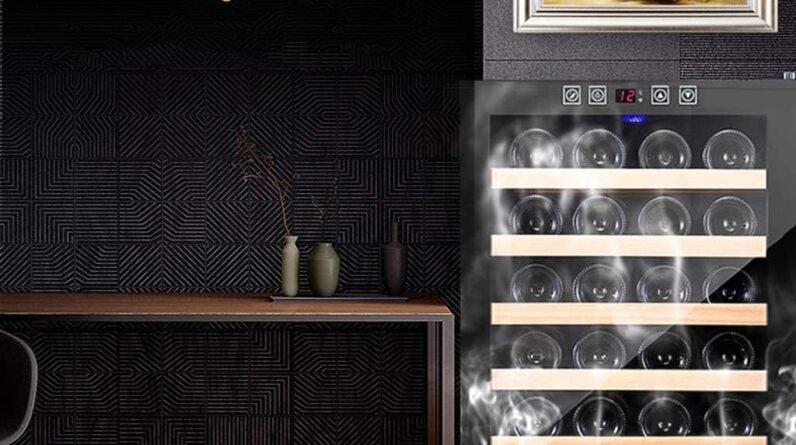
In today’s fast-paced world, more and more people are embracing the joy of home cooking, but taking necessary precautions to ensure oven safety is often overlooked. That’s why we’ve compiled a collection of essential oven safety tips that are designed specifically to protect home cooks. Whether you’re a seasoned chef or just starting out in the kitchen, these tips will help you navigate the potential hazards that come with using your oven, ensuring that you can create delicious meals without any unnecessary risks. From proper handling of hot trays to avoiding common pitfalls, read on to discover the key steps you can take to keep yourself, your loved ones, and your kitchen safe.
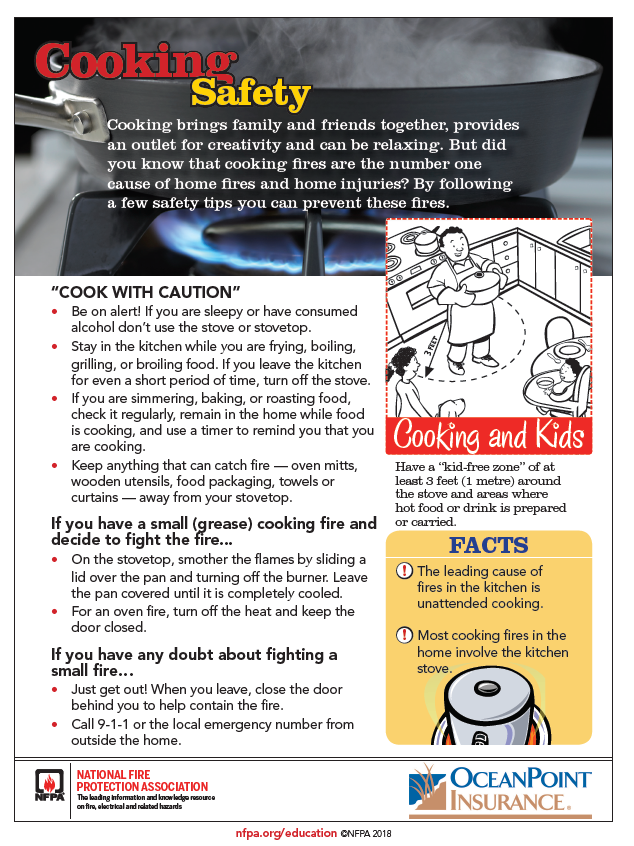
This image is property of www.oceanpointins.com.
1. General Oven Safety
1.1 Know Your Oven
It is important to familiarize yourself with the specific features and functions of your oven. Read the user manual and understand how to operate your oven properly. Take note of any safety precautions provided by the manufacturer.
1.2 Keep the Oven Clean
Maintaining cleanliness in your oven is crucial for both safety and food quality. Regularly clean the interior and exterior of your oven to prevent the buildup of grease, food particles, and other potentially flammable substances. Use a gentle oven cleaner and follow the manufacturer’s instructions for best results.
1.3 Test the Oven Temperature
Ensure that your oven is heating accurately by periodically testing its temperature. An oven thermometer can be used to verify if the temperature displayed by your oven matches the actual temperature inside. This will help you avoid undercooking or overcooking your dishes.
1.4 Use Oven Mitts
Always use oven mitts or heat-resistant gloves when handling hot cookware or bakeware. This will protect your hands from burns and prevent accidental spills or drops caused by heat-induced discomfort.
1.5 Be Mindful of Loose Clothing
When using your oven, be cautious of loose-fitting clothing, such as long sleeves or flowing scarves, that may accidentally come into contact with hot surfaces or open flames. Opt for fitted or shorter sleeves when operating your oven to reduce the risk of accidents.
1.6 Keep Children and Pets Away
To ensure the safety of your little ones and furry friends, it’s important to keep them at a safe distance from the oven while it is in use. A hot oven can be a potential hazard, and children or pets may accidentally touch the hot surfaces, causing severe burns.
1.7 Avoid Placing Items on Top of the Oven
To prevent accidental fires or damage, avoid placing any items on top of your oven. This includes kitchen towels, utensils, or flammable materials like paper or plastic bags. Keep the area around your oven clear to minimize the risk of accidents.
1.8 Don’t Leave the Oven Unattended
Never leave your oven unattended while it is in use. It’s essential to keep an eye on your cooking to prevent any potential hazards, such as overcooking, burning, or accidental fires. Stay in the kitchen and focus on your cooking tasks to ensure everything is going smoothly.
1.9 Check for Gas Leaks
If you have a gas oven, it is imperative to regularly check for gas leaks. Natural gas is odorless, but gas companies add a distinctive smell to help detect leaks. If you smell gas near your oven, immediately turn off the gas supply, open windows for ventilation, and contact a professional to inspect and repair any leaks.
1.10 Install a Carbon Monoxide Detector
Carbon monoxide (CO) is a colorless and odorless gas that can be produced by gas ovens. Install a carbon monoxide detector near your kitchen area to monitor the levels of CO and ensure the safety of your household. Regularly check and replace the batteries in the detector to maintain its effectiveness.
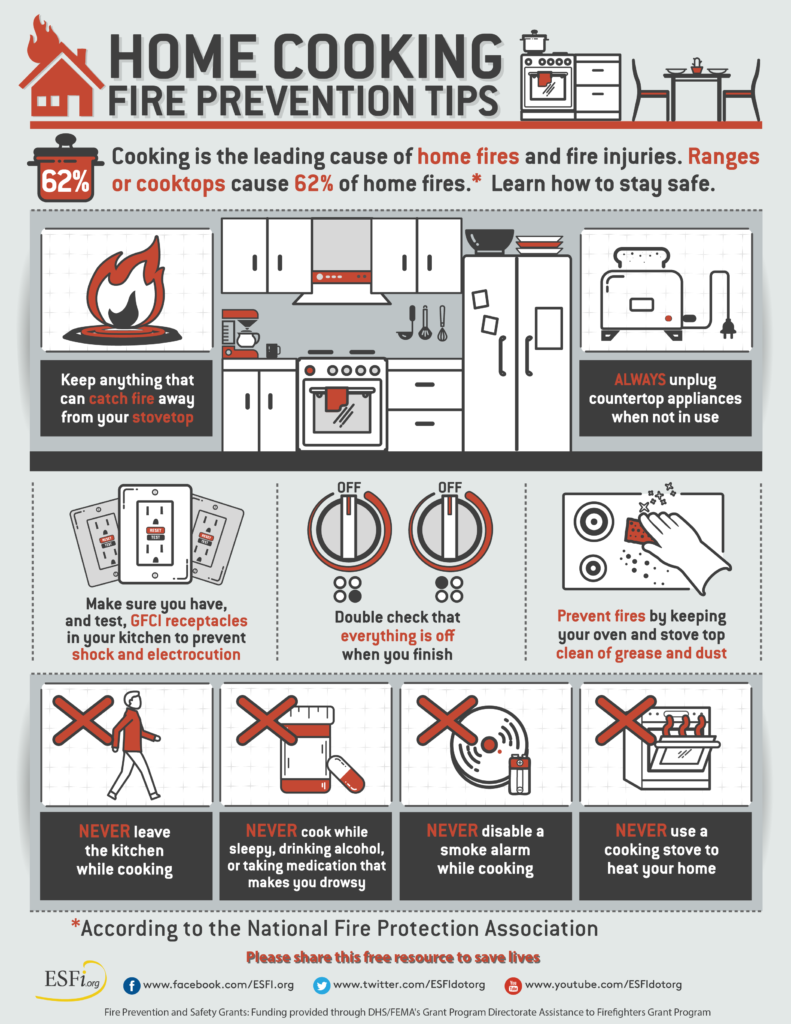
This image is property of www.esfi.org.
2. Proper Oven Usage
2.1 Preheat the Oven Correctly
Preheating your oven to the recommended temperature is essential for proper cooking. Follow the recipe instructions to determine the appropriate preheating time and temperature. This ensures that your dishes will cook evenly and thoroughly.
2.2 Use the Right Cookware
Using the appropriate cookware for your oven is crucial for safety and optimal cooking results. Ensure that your cookware is oven-safe and can withstand high temperatures without warping or releasing harmful chemicals. Check the manufacturer’s labels or instructions to verify their oven compatibility.
2.3 Use Oven-Safe Containers
When baking or roasting in your oven, always use oven-safe containers. Glass, ceramic, and stainless steel cookware are suitable options for oven use. Avoid using plastic or aluminum containers, as they may melt or react with the heat.
2.4 Avoid Overcrowding
To promote proper air circulation and even cooking, avoid overcrowding your oven with too many dishes at once. The heat needs to circulate freely around the food for it to cook thoroughly. If necessary, cook multiple batches or consider using a larger oven if you frequently find yourself running out of space.
2.5 Adjust Cooking Times and Temperatures
Different ovens may have variations in performance, so it’s important to monitor your dishes while they cook and adjust cooking times and temperatures accordingly. Use your senses, like sight and smell, to determine if your food is cooking as intended.
2.6 Keep Oven Racks in Place
Ensure that your oven racks are securely in place before placing any cookware on them. If the racks are not properly positioned, there is a risk of dishes tipping over, resulting in spills or burns. Take a moment to double-check the rack positions before each use.
2.7 Place Food in the Center
For optimal heat distribution, place your food in the center of the oven. This allows the heat to evenly surround the dish, resulting in more consistent cooking. Avoid placing dishes too close to the oven walls or directly under the heating elements.
2.8 Use Timer and Thermometer
Utilize a kitchen timer to track cooking times accurately. Set the timer to remind you when your dish should be checked or removed from the oven. Additionally, a food thermometer is essential for measuring the internal temperature of cooked meats, ensuring they reach the appropriate level of doneness and eliminating the risk of undercooked food.
2.9 Avoid Opening the Oven Door Frequently
Resist the temptation to frequently open the oven door while your food is cooking. Each time the door is opened, heat escapes, and the oven’s temperature drops, extending the cooking time. Only open the oven door when necessary, such as for basting or checking for doneness.
2.10 Allow for Proper Ventilation
When using your oven, ensure there is proper ventilation in your kitchen area. Open windows or turn on the exhaust fan to minimize the buildup of heat, steam, and odors. Adequate ventilation not only contributes to a more pleasant cooking environment but also reduces the risk of overheating the oven.
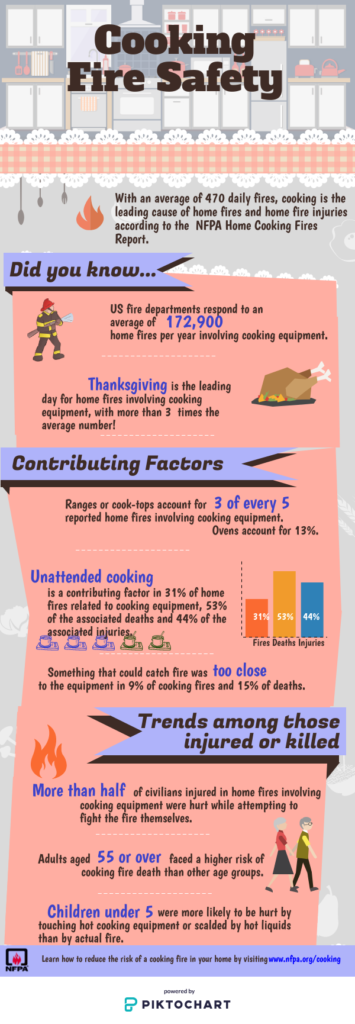
This image is property of www.nfpa.org.
3. Avoiding Oven Fire Hazards
3.1 Clean Up Spills Immediately
Accidents happen, and spills or drips in your oven can potentially ignite and cause a fire. Clean up any spills or food debris immediately after they occur to prevent them from accumulating and posing a fire hazard. Use a non-abrasive oven cleaner or a mixture of baking soda and water to safely remove spills.
3.2 Avoid Grease Build-up
Grease and oil can easily accumulate in your oven, increasing the risk of fire. Regularly clean your oven to remove any grease build-up, particularly in the oven cavity, on the burners or heating elements, and around the oven door. Taking preventive measures will significantly reduce the likelihood of a dangerous oven fire.
3.3 Use Oven-Safe Food Coverings
When cooking with high-fat or greasy foods, use oven-safe food coverings, such as a splatter guard or foil, to contain any potential splatters. This prevents the grease from reaching the heating elements or oven cavity, reducing the risk of fire and making cleanup easier.
3.4 Keep Flammable Items Away
To minimize the risk of fire, keep flammable items, such as potholders, paper towels, and wooden utensils, away from your oven while it is in use. Accidental contact with these items can cause them to catch fire, resulting in potential harm to yourself or damage to your kitchen.
3.5 Properly Store Flammable Liquids
Avoid storing flammable liquids, such as cleaning solvents or aerosol cans, near your oven. The heat from the oven can potentially ignite these substances, posing a severe fire hazard. Store flammable liquids in a cool, well-ventilated area away from any heat sources.
3.6 Don’t Use Metal in Microwave Oven
When using a microwave oven, avoid placing any metal objects or aluminum foil inside. Metal can cause sparks and potentially lead to a fire or damage to your microwave. Stick to microwave-safe containers and utensils to ensure safe and efficient cooking.
3.7 Use Oven Mitts, Not Dish Towels
While it may be tempting to use a dish towel or cloth to handle hot items from the oven, it is safest to use oven mitts or heat-resistant gloves specifically designed for high-temperature protection. Ordinary dish towels can easily catch fire or become too hot to handle, leading to accidents.
3.8 Avoid Overheating Oil
When cooking with oil, especially deep-frying, it is important to monitor the oil’s temperature closely. Overheated oil can ignite, leading to a dangerous fire. Use a deep-fry thermometer to keep track of the oil’s temperature, and never leave oil unattended on the stove.
3.9 Clean the Oven Vents
Ensure that the vents on your oven are clean and free from any obstructions. Clogged vents can prevent the oven from properly releasing heat and can increase the risk of overheating or fire. Regularly inspect and clean the vents to maintain proper airflow and prevent potential hazards.
3.10 Install a Fire Extinguisher in the Kitchen
It is crucial to have a fire extinguisher readily available in case of a kitchen fire emergency. Make sure the fire extinguisher is appropriate for use on different types of fires, such as those caused by grease or electrical appliances. Familiarize yourself with how to use the fire extinguisher properly and regularly check its expiration date.
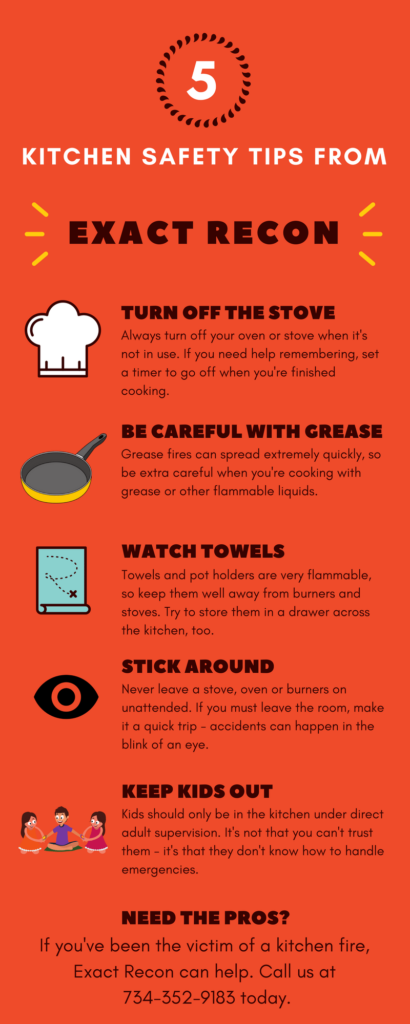
This image is property of exactrecon.com.
4. Maintenance and Safety Checks
4.1 Regularly Inspect the Oven’s Electrical Components
Inspect the electrical components of your oven periodically to ensure they are in good condition and free from any damage or wear. Check the power cord, wall outlet, and plug for any signs of fraying, exposed wires, or loose connections. If you notice any issues, contact a qualified professional to repair or replace the faulty parts.
4.2 Test Oven Door Seal
A tight and secure oven door seal is crucial for energy efficiency and preventing any heat leakage. Periodically inspect the seal around the oven door to ensure it is intact and free from cracks or damage. If you notice any gaps or issues with the seal, it should be replaced promptly to maintain optimal oven performance.
4.3 Check for Gas Leaks
For gas ovens, regular checks for gas leaks are vital for safety. If you detect a suspicious odor resembling rotten eggs (added to natural gas for detection purposes), immediately turn off the gas supply, open windows for ventilation, and contact a professional to inspect and fix any leaks.
4.4 Keep Oven Properly Ventilated
Adequate ventilation is essential for safe operation and optimal functioning of your oven. Ensure that the space around the oven is not obstructed, allowing proper airflow and preventing overheating. Avoid covering or blocking the oven vents, as this can lead to heat buildup and potential safety hazards.
4.5 Clean or Replace Oven Filters
If your oven has filters, such as range hood or grease filters, they should be routinely cleaned or replaced as recommended by the manufacturer. Dirty or clogged filters can hinder proper ventilation and potentially contribute to an accumulation of grease or heat, increasing the risk of fire.
4.6 Verify Proper Wiring
If you experience any electrical malfunctions or suspect wiring issues with your oven, it is advisable to consult a qualified electrician. Proper wiring is essential for safe and efficient operation, minimizing the risk of electrical fires and ensuring the longevity of your oven.
4.7 Schedule Professional Maintenance
To ensure that your oven is in optimal working condition and to address any potential safety concerns, consider scheduling regular professional maintenance. A trained technician can thoroughly inspect your oven, perform necessary repairs, and provide valuable advice on proper oven usage and maintenance.
4.8 Replace Faulty Parts Immediately
If you notice any faulty or malfunctioning parts in your oven, such as heating elements, thermostat, or control knobs, it is crucial to replace them promptly. Delaying repairs or continuing to use defective parts can compromise the safety of your oven and increase the risk of accidents or malfunction.
4.9 Know the Signs of Carbon Monoxide
Carbon monoxide (CO) is a silent killer that can be emitted by gas ovens. Educate yourself and your household on the signs and symptoms of carbon monoxide poisoning, such as headaches, dizziness, nausea, and confusion. If you suspect carbon monoxide exposure, immediately exit the premises, seek fresh air, and contact emergency services.
4.10 Keep Emergency Numbers Handy
In case of any emergencies, it is essential to have emergency numbers readily accessible in your kitchen. Keep important contact information, such as local fire departments, poison control centers, and emergency services, close to your oven or on the refrigerator for quick access during urgent situations.
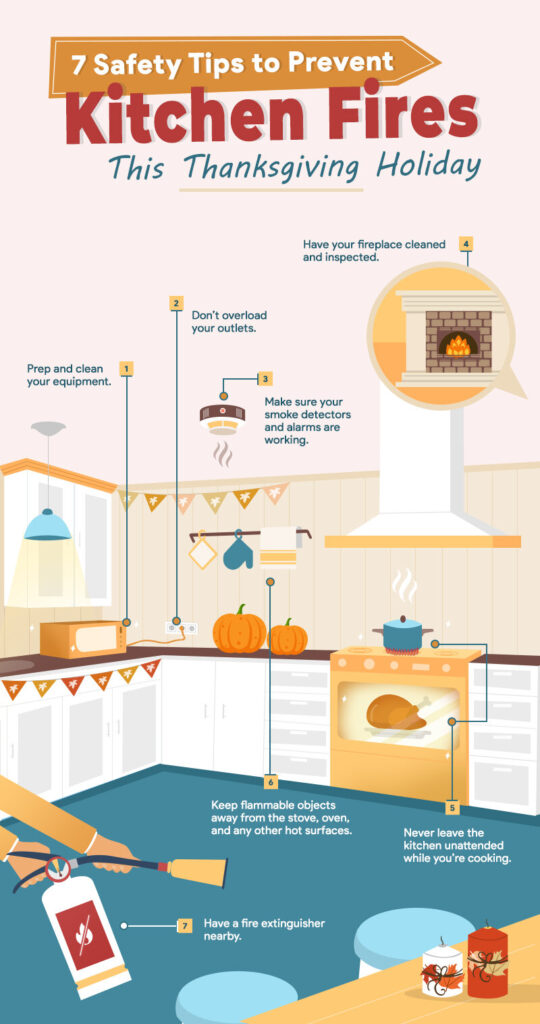
This image is property of images.squarespace-cdn.com.
5. Safe Oven Cleaning Practices
5.1 Disconnect and Remove Oven Racks
Before cleaning your oven, disconnect it from the power source and remove the oven racks. This will allow you easier access to the inside of the oven and prevent any accidental burns or injuries while cleaning.
5.2 Use Oven-Safe Cleaners
Choose oven cleaners specifically formulated for use inside ovens. These cleaners are designed to effectively remove grease, grime, and food residues without causing damage to the oven’s interior surfaces. Follow the manufacturer’s instructions and safety precautions when using any cleaning products.
5.3 Follow Manufacturer’s Instructions
Always refer to the manufacturer’s instructions and guidelines for cleaning your specific oven model. These instructions will provide valuable information on the recommended cleaning methods, materials to use, and any precautions you should take to protect yourself and your oven.
5.4 Avoid Using Harsh Chemicals
While it may be tempting to use strong chemicals to tackle stubborn stains or grease build-up, it’s important to avoid harsh cleaning agents that can damage your oven’s surfaces or release toxic fumes. Stick to mild, oven-safe cleaners or natural cleaning solutions like baking soda and vinegar.
5.5 Use Protective Gear
When cleaning your oven, protect yourself by wearing gloves, safety goggles, and a face mask if necessary. Cleaning agents and debris can irritate your skin, eyes, or respiratory system, so take precautions to minimize any potential risks.
5.6 Ventilate the Room
Promote proper air circulation by opening windows or turning on exhaust fans when cleaning your oven. Ventilating the room will help dissipate any fumes from cleaning agents and ensure a more comfortable and safe environment.
5.7 Deep Clean Regularly
To maintain optimal oven performance and safety, incorporate regular deep cleaning sessions into your cleaning routine. Deep cleaning involves removing and cleaning oven racks, wiping down all surfaces, and paying attention to areas prone to grease accumulation, such as the oven door and cavity.
5.8 Check for Residual Cleaning Agents
After cleaning your oven, thoroughly inspect all surfaces to ensure that no cleaning agents or residues are left behind. Any remaining cleaning agents can potentially generate harmful fumes or affect the taste and safety of your food. Wipe down all surfaces with a damp cloth to remove any traces of cleaning agents.
5.9 Dispose of Household Wastes Properly
When discarding cleaning materials or waste generated from oven cleaning, ensure that you do so in accordance with local regulations. Some cleaning products may require special disposal methods. Check with your local waste management authority to determine the proper disposal procedures for your area.
5.10 Prevent Bacterial Contamination
To avoid bacterial contamination, it is important to sanitize your oven regularly. High heat can help kill bacteria, so after deep cleaning, you can set your oven to a high temperature for a short period to ensure any remaining bacteria are eliminated. Additionally, avoid cross-contamination by thoroughly washing oven mitts, cleaning cloths, and any other items that come into contact with raw or contaminated food.
By following these essential oven safety tips, you can protect yourself, your loved ones, and your home while enjoying the benefits of cooking and baking in your oven. Remember to prioritize safety, stay vigilant, and practice proper maintenance to create a safe and enjoyable cooking environment.
